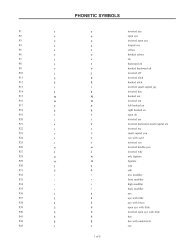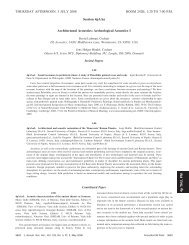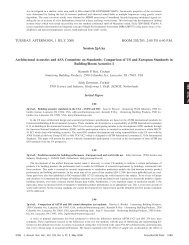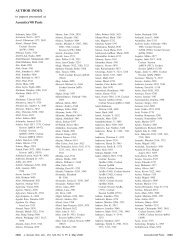Tuesday afternoon, 11 November - The Acoustical Society of America
Tuesday afternoon, 11 November - The Acoustical Society of America
Tuesday afternoon, 11 November - The Acoustical Society of America
Create successful ePaper yourself
Turn your PDF publications into a flip-book with our unique Google optimized e-Paper software.
Ridgway has also strived to develop techniques that would allow routine clinical hearing assessment <strong>of</strong> captive animals. This talk<br />
reviews the development <strong>of</strong> AEP techniques for rapid large-scale hearing assessment in dolphins at the US Navy Marine Mammal<br />
Program. Topics range from Ridgway’s early work on dolphin AEP threshold measurements to recent efforts to acquire longitudinal<br />
audiometric data from a large population <strong>of</strong> dolphins. Work supported by ONR.<br />
2:30<br />
2pAB4. Application <strong>of</strong> the evoked-potential method to the study <strong>of</strong> the odontocete biosonar. Alexander Supin Inst. <strong>of</strong> Ecology and<br />
Evolution, Russian Acad. <strong>of</strong> Sci., 33 Leninsky Prosp., <strong>11</strong>9071 Moscow, Russia<br />
In a false killer whale Pseudorca crassidens, auditory evoked potentials AEPs were recorded in conditions <strong>of</strong> echolocation using<br />
both real targets and electronically synthesized and played-back phantom echoes. <strong>The</strong> electronic echoes were triggered by emitted<br />
sonar pulses, their spectra were similar to that <strong>of</strong> the emitted sonar clicks <strong>of</strong> the subject, and their intensities were proportional to the<br />
level <strong>of</strong> the emitted sonar pulse. AEPs to both the emitted pulse and real or electronic echoes were well detectable. AEPs related to<br />
emitted sonar clicks displayed the regular amplitude dependence on click level: <strong>The</strong> higher the level, the higher the amplitude. <strong>The</strong><br />
echo-related AEP amplitudes depended on both echo attenuation and delay with a trade <strong>of</strong> around 9-dB attenuation per delay doubling.<br />
When the echo attenuation was varied in conjunction with delay keeping a rate <strong>of</strong> 9-dB deeper attenuation per delay doubling, the<br />
echo-related AEPs were nearly invariant. This result is well explainable by a hypothesis implying that partial forward masking <strong>of</strong> echoes<br />
by preceding emitted sonar pulses serves as a mechanism <strong>of</strong> automatic gain control in the auditory system <strong>of</strong> echolocating odontocetes.<br />
2:50<br />
2pAB5. Perception <strong>of</strong> echoes with FM1-FM2 delay disparities: Bats have selective direction-<strong>of</strong>-gaze high-resolution imaging.<br />
James A. Simmons Dept. <strong>of</strong> Neurosci., Brown Univ., Providence, RI 02912, james-simmons@brown.edu, Mary E. Bates, Sarah A.<br />
Stamper and Douglas Benedicto Brown Univ., Providence, RI 02912<br />
Echolocating big brown bats Eptesicus fuscus emit frequency-modulated FM biosonar sounds containing two prominent downsweeping<br />
harmonics, FM1 from 55 to 23 kHz and FM2 from 100 to 45 kHz. Acoustics <strong>of</strong> echoes in air ordinarily keep FM1 and FM2<br />
aligned in time; however, if FM1 and FM2 are segregated artificially with low-pass and hig-hpass filters and delivered to bats at different<br />
delays, accuracy <strong>of</strong> delay perception is disrupted. As a direct confirmation <strong>of</strong> delay-resolution results from echo jitter experiments,<br />
harmonic delay <strong>of</strong>fsets <strong>of</strong> 1–2 us are sufficient for the bat to reject echoes from accurate delay determination. Echoes ordinarily do arrive<br />
with differentially greater attenuation <strong>of</strong> FM2 relative to FM1 for longer ranges FM2/FM1 is 3 dB for a range <strong>of</strong> 2 m and for <strong>of</strong>f-axis<br />
targets FM2/FM1 added 3 dB for angles <strong>of</strong> 15 deg at a 2-m range. <strong>The</strong> resulting greater neuronal amplitude-latency trading for FM2<br />
relative to FM1 activates the harmonic delay-<strong>of</strong>fset effect to prevent accurate determination <strong>of</strong> delay. Noncoherence <strong>of</strong> harmonics in<br />
auditory neuronal spectrograms shunts information about the <strong>of</strong>f-axis and far away targets to a different display <strong>of</strong> range and crossrange<br />
than for targets located in the direction <strong>of</strong> gaze. Work supported by the ONR and the NIMH.<br />
3:25<br />
2pAB6. Underwater sound measurements <strong>of</strong> the Hawaii super ferry and<br />
the potential impact to humpback whales in the main Hawaiian Islands.<br />
Alison K. Stimpert, Alexis Rudd, and Whitlow W. L. Au Inst. <strong>of</strong> Marine<br />
Biology, Univ. <strong>of</strong> Hawaii, P.O. Box <strong>11</strong>06, Kailua, HI 96734<br />
Underwater measurements <strong>of</strong> the Hawaii Super Ferry were made with a<br />
vertical array <strong>of</strong> four hydrophones. <strong>The</strong> depths <strong>of</strong> the hydrophones were 3,<br />
6.5, 10, and 20 m. <strong>The</strong> Alakai is a 107 m catamaran passenger and automobile<br />
ferry that has a waterjet propulsion system with no exposed propellers.<br />
<strong>The</strong> Alakai made three close proximity passes at speeds <strong>of</strong> 37, 24, and 12 kn<br />
on tracks that allowed for acoustic measurements <strong>of</strong> sounds radiating from<br />
the bow, broadside, and stern aspects. <strong>The</strong> track <strong>of</strong> the Alakai was recorded<br />
on global positioning system. <strong>The</strong> measurements were conducted while the<br />
ferry proceeded on normal scheduled trips, allowing for three measurements<br />
a day. All the sound pressure levels were referenced to 91 m 100 yards, the<br />
minimum legal approach distance <strong>of</strong> boats to humpback whales. Sound intensity<br />
increased with speed and was the highest at 37 kn in the broadside<br />
aspect 160 dB and was 14 dB lower for both the bow and stern aspects.<br />
<strong>The</strong> sounds had a broadband noise quality with spectra that had a low frequency<br />
peak below 100 Hz and decreased continuously with frequency. <strong>The</strong><br />
effects <strong>of</strong> the sounds will be discussed from a humpback whale perspective.<br />
3:10—3:25 Break<br />
Contributed Papers<br />
3:40<br />
2pAB7. Patterns <strong>of</strong> coastal use by Hawaiian spinner dolphins (Stenella<br />
longirostris) observed using passive acoustic monitoring. Marc O.<br />
Lammers Hawaii Institue <strong>of</strong> Marine Biology, P.O. Box <strong>11</strong>06, Kailua, HI<br />
96734, lammers@hawaii.edu, Simona Bernasconi CIBRA, Universita Degli<br />
Study di Pavia, Pavia 27100, Italy, Whitlow W. L. Au Hawaii Inst. <strong>of</strong><br />
Marine Biology, Kaneohe, HI 96744, Kevin Wong, and Russell E. Brainard<br />
Pacific Islands Fisheries Sci. Ctr., Honolulu, HI 96822<br />
Spinner dolphins are the most commonly sighted cetacean in coastal Hawaiian<br />
waters and are an important higher-level trophic component <strong>of</strong> the<br />
near-shore ecosystem. Establishing their long-term patterns <strong>of</strong> occurrence is<br />
important both for their conservation and for a better understanding <strong>of</strong> the<br />
relationships between dolphins, their prey, and other members <strong>of</strong> the<br />
ecosystem. Here we report on an effort to use ecological acoustic recorders<br />
EARs to monitor the presence <strong>of</strong> spinner dolphins along the leeward coast<br />
<strong>of</strong> the island <strong>of</strong> Oahu, Hawaii. <strong>The</strong> EAR is a bottom-moored recorder with<br />
a bandwidth <strong>of</strong> 30 kHz, which allows the detection <strong>of</strong> both dolphin whistles<br />
and echolocation clicks. Eight EARs were deployed along the coast at<br />
depths ranging from 15 to 50 m. Five units were deployed in an array, providing<br />
information about the EAR’s detection range. <strong>The</strong> other three units<br />
were placed at sites along the coast commonly frequented by spinner<br />
dolphins. <strong>The</strong> results reveal distinct patterns <strong>of</strong> preference in habitat use,<br />
2483 J. Acoust. Soc. Am., Vol. 124, No. 4, Pt. 2, October 2008 156th Meeting: <strong>Acoustical</strong> <strong>Society</strong> <strong>of</strong> <strong>America</strong><br />
2483<br />
2p TUE. PM







